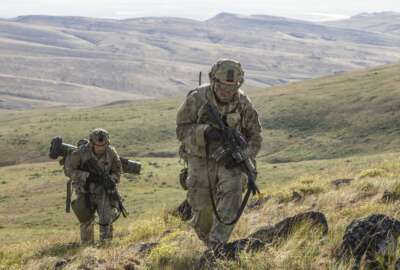Hubbard Radio Washington DC, LLC. All rights reserved. This website is not intended for users located within the European Economic Area.
From recruitment to retention, Army puts more management focus on civilian workforce
In the last year, the Army said its "People Strategy" led to major gains in recognizing the value of its civilian workforce, spurring recruitment and career dev...
The Army has made significant strides over the past year in adding more rigor to the way it manages its civilian workforce. Among the changes: A brand new agency that will manage a series of restructured civilian career pathways and give employees a wider range of opportunities, new ways to measure how civilians contribute to Army readiness, faster hiring timelines, and new approaches to recruiting the best and brightest from academia into the civil service.
The changes are happening as part of the Army’s broader “people strategy” and a subsidiary implementation plan that applies specifically to civilians. Officials call the latter plan a “living document.” The first version was released a year ago, and a 2.0 version is due for release next spring.
Christopher Lowman, the senior official performing the duties of the undersecretary of the Army, said the overarching goal for the civilian portion of the strategy — much like its military counterpart — is to use modern talent management practices to sure the Army has the skills it needs for a future of “multidomain operations” (MDO).
“The question is, do we have the right skills at the right place to support an MDO-capable army that’s fast, lethal and mobile? That’s what the future battlefield is going to look like. We’re going to have to be able to respond with the skill sets that we own — and that only our civilians can bring to the table — to support the warfighter,” he said during a civilian forum at the annual Association of the U.S. Army conference in Washington. “That’s what the strategy and implementation are all about. How do I identify the skill sets I need, how do I acquire those skill sets, deploy them and retain them?”
So far, one of the most concrete outcomes of the implementation has been the standup of a brand new agency to manage civilian career fields. The Army Civilian Career Management Activity (ACCMA) reached full operational capability this month.
As part of that process, the Army also restructured its 32 career programs, consolidating them into 11 broader career fields. One goal is to give employees more flexibility to take their skills from one position to another within those broader fields. Another is to take a less siloed approach to new employee recruitment.
Edward Emden, ACCMA’s director, said it’s the first time the service has mapped out Army-wide strategies to attract new civilian employees, including by building civilian recruitment into its public marketing campaigns.
“A few commands have had recruitment efforts, but they were really one-offs, specific to their commands,” he said. “This is the first time that we’ve had an enterprise approach to recruitment. We have been building partnerships with various universities throughout the years to access some of their talents and their events, and we’re very proud that we hosted our first recruitment event in August of this past year. We’re going to host a total of 50 events in fiscal 2022 to ensure we have the access to top talent as well as diverse talent to really build our workforce.”
And the Army has opened up new channels to recruit civilians, particularly younger prospects.
Also in August, the service stood up a new internship program to target students who are still in college, hopefully piquing their interest in government service before they graduate. A second initiative, dubbed the Army Fellows program, replaces the Army’s previous apprenticeships for new college graduates.
And a third specifically targets college students pursuing STEM degrees. In exchange for four years of obligated service as an Army civilian once they graduate, the Army will reimburse 50% of their college tuition, and cover other expenses like books.
“That’s talent acquisition in the skill sets that we need, and the number-one pushback I got in every single meeting was, ‘Well, we’re going to hire them, and then they’re going to leave after four years,’” Lowman said. “And some of them might, but we’ll hire 1,000 over the next five years. So even if 50% leave, we have 500 more than we started with. And you’ll have 500 people who now have a history of service and understand what it means to serve their nation. That’s a win-win.”
For almost all of those fresh-out-of-college hires, the Army is using direct-hire authorities to speed up the government’s famously slow onboarding process. Over the past year, 97 percent of interns and fellows were brought on board as direct-hires.
And the service has also made progress toward reducing its overall time-to-hire. Officials say they’re now closing in on the Office of Management and Budget’s goal of 80 days, compared to an Army-wide average of 91 days as of 2019.
But the implementation plan isn’t just focused on hiring the right employees. The other pillars involve developing, employing, and retaining talent. And the people strategy helped officials realize they had major work to do in those areas too.
For example, a vast proportion of supervisors in the Army civilian corps weren’t getting the leader development training that the service’s own regulations require, said Michael Formica, the deputy to the commanding general at the Army’s Combined Arms Center at Fort Leavenworth.
“There are 38,000 [civilian] supervisors in the Army, but less than 50% of them have been educated at the appropriate level to perform those responsibilities. There isn’t a leader in the Army that would allow that to happen in the uniformed cohort,” he said. “But the Army Management Staff College has done a great job redesigning that course to ensure that the leader competencies that our army recognizes, and are critical to leadership, are built into their curriculum.”
Beyond formalized training, the Army is creating a “latticed” model to develop its civilian leaders by letting them pursue broadening assignments outside of what had been more rigid career tracks. That model is part of a forthcoming training and development strategy that’s expected to be laid out in the next version of the civilian implementation plan.
Another item on the to-do list is coming up with ways to clearly quantify and describe how Army civilians contribute to military readiness.
“The Army has not yet defined what that means. We need to be able to look a senior leader in the eye and say, ‘We’ve got a problem, because we don’t have enough dollars to do this, and it’s directly impacting the readiness of the Army,” he said. “So we have commissioned a RAND Corporation study that’s going to dig into that and give us some thoughtful approaches to what [civilian readiness] can look like on a pretty fast timeline. We’ve also shown some success with our Army Staff, where we’re going to start capturing the strategic readiness tenets of training and leading for the civilian cohort. The metrics aren’t where they need to be, but we’re now at the table, and we have an opportunity to highlight to the senior leadership how well the civilian cohort is doing.”
One reason Army officials are optimistic that they’ll be able to make meaningful improvements to how civilians’ careers are managed — and hopefully encourage their best talent to stick around for longer — is that the Army now has formal governance structures to oversee and set policy for the civilian workforce as a whole.
Three new bodies – a career management executive council, a human resources executive council, and civilian enterprise steering committee will all report to a new Army People Strategy Board of Directors, which will in turn report to the Secretary of the Army and the Army Chief of Staff each quarter.
Those new governance structures, combined with improved data analytics across the whole of the Army civilian workforce, should eventually let the service do a much better job of predicting its workforce needs, and matching talent to demand, said Carol Burton, the director of the Army Civilian Human Resources Activity.
But that’s a stretch goal, she said.
“Today, we don’t have a way to do that: we post-and-pray, or we attend job fairs,” Burton said. “But what we’re going for is a talent marketplace where we can forecast requirements and determine what skill sets we have. And then, if we need a future skill set and don’t have it, we can either start to train towards that requirement, or we can acquire new talent. It’s a huge initiative and it’s super hard. If it was easy, we would have already done it. This is going to be a multi-year project.”
Copyright © 2024 Federal News Network. All rights reserved. This website is not intended for users located within the European Economic Area.
Jared Serbu
Jared Serbu is deputy editor of Federal News Network and reports on the Defense Department’s contracting, legislative, workforce and IT issues.
Follow @jserbuWFED





